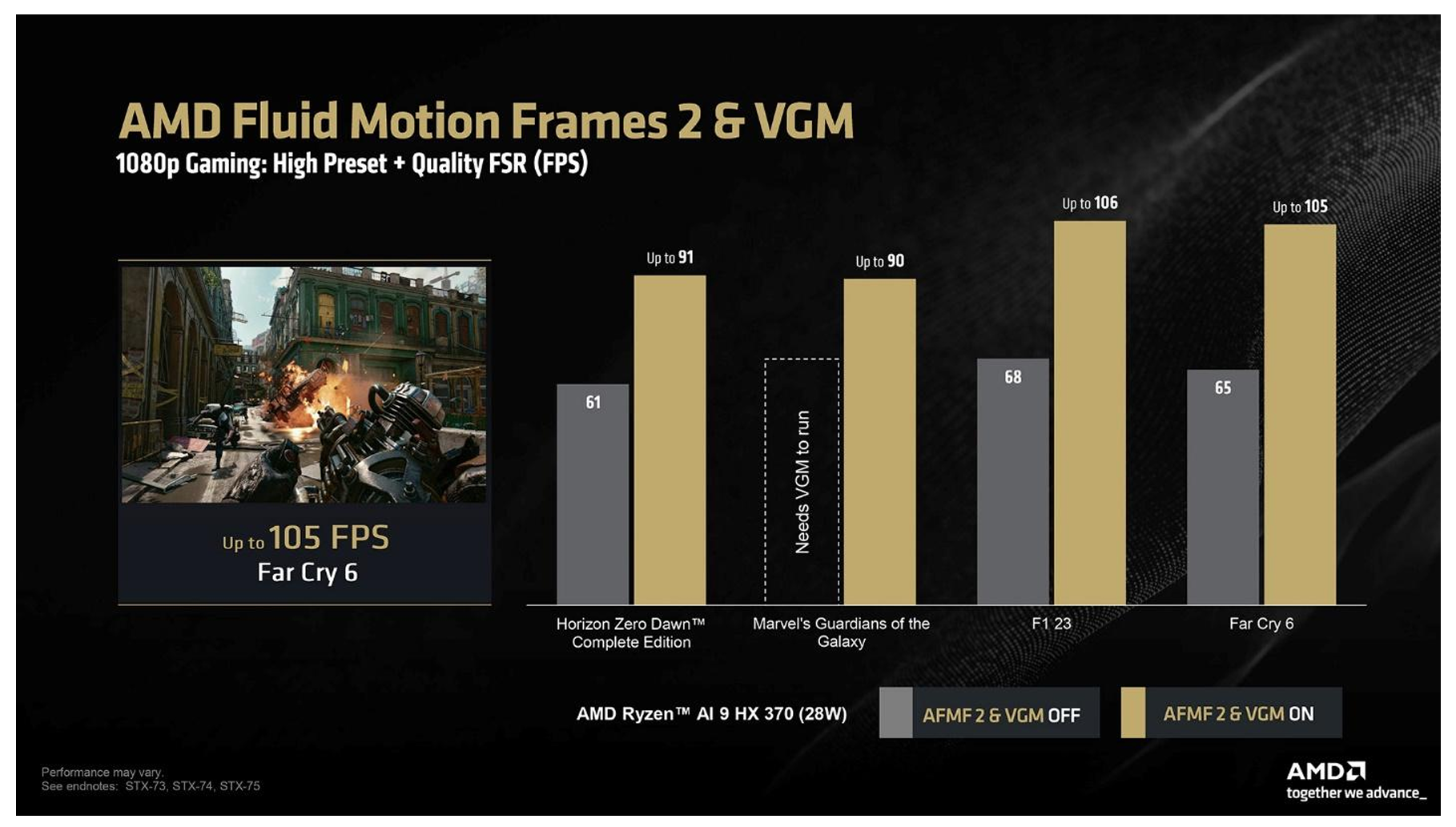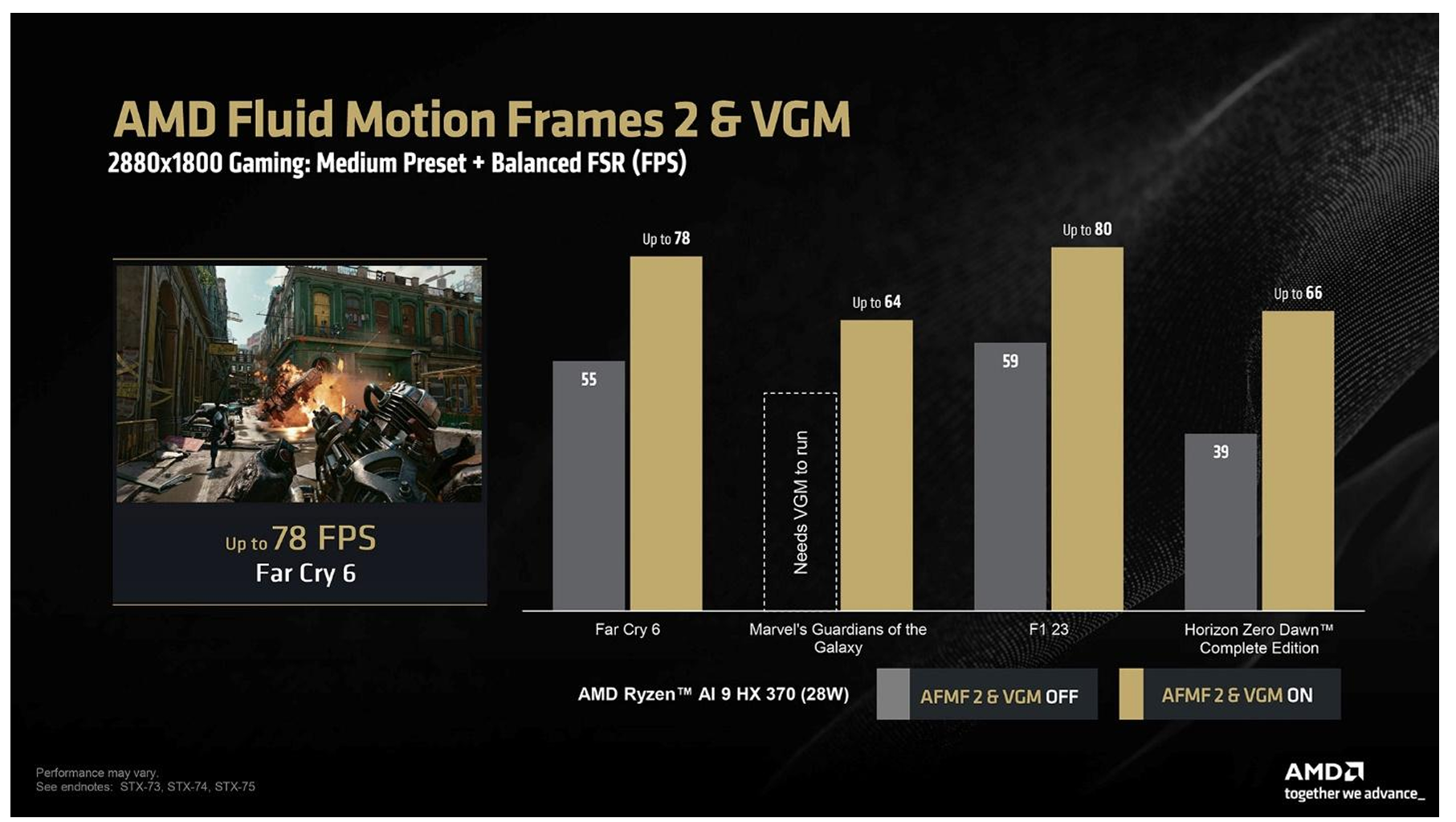
Image: AMD
AMD is offering gamers an early version of what it calls AMD Fluid Motion Frames 2 (AFMF2), an AI-powered technology that creates additional frames per second for those gamers with laptops powered by AMD Ryzen AI 300 processors. The improvements appear significant: about 30 to 40 percent.
Specifically, AMD says that AFMF 2 will boost frame rates in Cyberpunk: 2077 from 56 frames (1080p, Low settings, Balanced FSR) to about 100 FPS using the new technology, and other games will see a similar boost. For now, AMD is offering AFMF 2 as a technical preview, though the technology will be added to AMD’s Adrenalin Edition software at a later date.
AFMF2 is the second generation of the AFMF technology AMD launched in January. The Adrenalin Edition software offers several tools to enhance gameplay; Radeon Super Resolution, for example, upscales a rendered frame of a game to approximate a higher-resolution scene.
Gamers tend to prefer the highest frame rates at the highest resolution at the highest visual quality possible. AFMF2 addresses the first portion of that, using AI and artificially creating additional frames in between what the game demands the GPU draw. The additional frames smooth out the gameplay experience, making it look and feel like a more powerful GPU is in place. All of these new capabilities are stored within what AMD calls its HYPR-RX profiles for games.
Variable Graphics Memory: a new addition
There is something new, however. AFMF 2 works in conjunction with Variable Graphics Memory, a new feature which AMD is adding to its bag of tricks. VGM allows the laptop to re-allocate up to 75 percent of the system memory to dedicated VRAM (as opposed to memory that’s already shared between the CPU and GPU).
The message here is pretty simple: if you buy a Ryzen AI 300 laptop with lots of system RAM (32GB, say, versus a 16GB system) some of that system RAM can be allocated to the GPU, increasing gaming performance. On a 32GB system, for example, AMD said that the “dedicated” VRAM would be increased from 512MB to a whopping 8GB on a Radeon 890M system, upping the overall graphics performance.
VGM must also be enabled, however. Under the Performance settings inside the Adrenalin application, VGM can be turned on using the Tuning tab. Your options will be Low, Medium or High; the latter two options will essentially turn on VGM to its maximum capabilities.
Like AFMF, the second-generation AFMF 2 and VGM can’t create something from nothing. The company said Wednesday that it recommends gamers try to tune the game to allow for at least 50 fps using various combinations of resolution and graphics level, than let AFMF 2 boost the frame rates further. The AFMF 2 boost will also vary by system and by game, of course.


Still, the projected improvements are impressive. AMD compared two AI 9 HX 370 systems, one with AFMF 2/VGM off, and one with it on. Frame rates shot up dramatically. Even better, the improvements carried over from 1080p gaming to older games run at up to 2,880×1,800 resolution.
These AI-boosted improvements to gaming aren’t exclusive to AMD, of course. Nvidia has its own AI-powered frame interpolation technology, within the DLSS 3 technology that both upscales graphics and injects additional AI-powered frames — though you need a dedicated Nvidia graphics card installed to use it, while AMD’s AFMF2 also works with integrated laptop graphics. Still, however, you cut it, they’re both solid arguments for investing in the latest CPU and GPU technology.
Further reading: The best gaming laptops we’ve tested
Author: Mark Hachman, Senior Editor, PCWorld

Mark has written for PCWorld for the last decade, with 30 years of experience covering technology. He has authored over 3,500 articles for PCWorld alone, covering PC microprocessors, peripherals, and Microsoft Windows, among other topics. Mark has written for publications including PC Magazine, Byte, eWEEK, Popular Science and Electronic Buyers’ News, where he shared a Jesse H. Neal Award for breaking news. He recently handed over a collection of several dozen Thunderbolt docks and USB-C hubs because his office simply has no more room.
